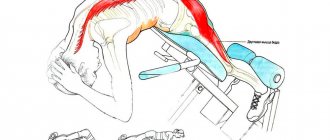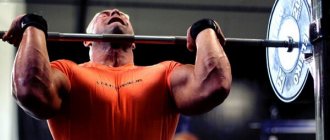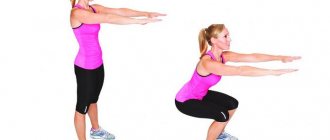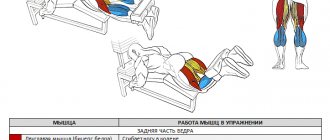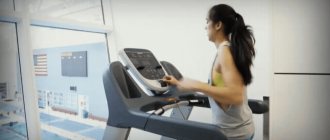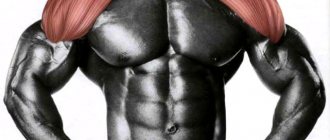Shrugs, or shrugs, are a classic exercise for developing the trapezius muscles located in the upper back. Most athletes prefer to perform shrugs with dumbbells. They can also be done with a barbell, in a machine or on parallel bars. The exercise is suitable for athletes with an above-average level of training who use isolated training of even small muscle groups. For beginners, as a rule, the load that the trapezius receives when performing basic exercises is sufficient.
General characteristics
At first glance, the standing shrug exercise looks simple and straightforward. Essentially, a shrug is raising your shoulders in a standing position with weights. But beginners should not rush to get acquainted with it, because often the back muscles are not prepared for this type of load. Shraghi helps already experienced athletes complete the formation of a beautiful and powerful back.
Shrugs help to influence the target muscle (trapezius) locally, in isolation. The deltas, forearms and rhomboid muscles act as assistants. The biceps play the role of stabilizers. As a result, that part of the trapezius is formed that is very difficult to load with other exercises.
Shragging is also recommended for people with sedentary and sedentary jobs. Exercise will help relieve stress, fatigue and tension. But here we mean, rather, a light warm-up, and not a full-fledged workout. Let us repeat once again that only trained athletes can begin working with heavy weights.
The target muscle responds very gratefully to the right loads and pretty soon you will get a pumped-up neck, a convex upper back and developed shoulders. This characteristic does not fit the description of an elegant female figure - girls do not have to exclude the exercise completely, but they should not get carried away with it.
You can work in several variations: shrugs with dumbbells or with a barbell, shrugs in a Smith machine. Each variation has its own characteristics, without which it will be difficult to achieve the goal.
Recommendations for performing the exercise
Despite their simplicity, shrugs have their own nuances:
- We have already noted that you should not “drop” your shoulders. If you push them down sharply every time, there will be a significant load on the joints, which can harm them.
- In addition, you should not lower your shoulders too low in principle. If you feel a stretch, that's not a good thing, and again you could injure yourself.
- Rotational or lateral movements are another way to damage joints.
- Do not help yourself with your biceps, do not bend your elbows.
- The head should be pointed straight.
- Do not start shrugs at the beginning of your back workout, use them as the final stage. In any case, you first need to warm up and prepare your muscles; to do this, do at least 2 sets of pull-ups on the horizontal bar.
Shrugs are most often practiced by professional and experienced athletes when they want to achieve an ideal upper back shape. But it’s also worth trying if you need to get rid of stoop, develop and strengthen muscles. Girls who do not want to part with the grace of their necks and beginners should avoid shrugs.
Shrugs with dumbbells
Shrugs with dumbbells are performed as follows:
- We stand straight, the distance between the feet is equal to the width of the shoulders, dumbbells at hip level (palms turned towards you). In the starting position, we lower our shoulders as low as possible to obtain a wide amplitude. We fix the body, look in front of us;
- We work according to the scheme: inhale - exit and raise the shoulders up - fixate - return to the starting position. At the top point we try to achieve maximum muscle contraction. Figuratively, we try to reach our earlobes with our shoulders. Only the shoulders work. The trajectory of movement is strictly up and down. The body and arms are straight.
The technique of performing shrugs with dumbbells is quite simple, there is practically no risk of making a mistake. To better control the correct position, watch your reflection in the mirror.
Explanations
- Your arms help you support the weight. This completes their mission. Avoid bending your elbows.
- Watch the movement of your shoulders. Pulling back at the top will shift the load.
- We raise our shoulders as high as we can. The effect of standing dumbbell shrugs depends on this.
- At the top point the delay time should be at least 2 seconds.
- The body is fixed in a vertical position. Tension in the muscles will help stabilize your back.
- We return to the starting position without jerking. An explosion is only appropriate when lifting dumbbells.
- Use safety straps and straps to support heavy weights.
For those who like to see more than read, watch this video:
What is a trapezoid
Please don’t judge me harshly, but this blog was created primarily for bodybuilding beginners , and therefore I can’t help but start with the basics of muscle building. So, according to Wikipedia
The trapezius muscle is a flat, broad muscle that occupies a superficial position in the back of the neck and upper back. The trapezius muscle has the shape of a triangle, with its base facing the spinal column and its apex facing the acromion of the scapula. The trapezius muscles on both sides of the back together have the shape of a trapezoid (source https://ru.wikipedia.org/wiki/Trapezium).
Many beginners usually make one of two classic mistakes . Some swing absolutely no exercises without doing the trapezius , others , on the contrary, pay too much attention to the trapezius muscles to the detriment of other, more important muscles. Today I will try to make it clear how to properly swing the trapezius, so that it is neither too much nor too little. I even came up with a formula for this (the formula will be below).
Yes, the trapeze is spectacular, it’s beautiful. But this does not mean that you need to pump up the trapezius muscles at every workout with all available exercises.
Shrugs with a barbell
To perform this type of shrug, more serious weights are used. It is not recommended to start performing without a safety weightlifting belt, wrist straps and gloves. There is a risk of injury.
Shrugs with a barbell technique:
- starting position: it is recommended to take the bar with a grip slightly wider than shoulder width. We align the body, reach the top of the head towards the ceiling, and shoulders towards the floor. There is a slight natural curve in the lower back. We look straight ahead. Arms straight;
- as you exhale - with the force of the trapezius, the shoulders rise up, fixing at the extreme point for a couple of seconds and smoothly returning to the starting position;
- It is very important to ensure that your arms are straight, that your torso is not tilted, and that your knees are not bent. You just need to shrug your shoulders, reaching the peak contraction at the top point.
Explanations
- While working, look at yourself in the mirror. Looking straight ahead will help prevent slouching. Tilts of the head to the right/left will lead to asymmetrical development of the trapezius.
- Avoid slouching. It will be easy to keep your shoulders in the correct position with your back and chest straightened.
- If you feel that you cannot keep your shoulders abducted, then for now work only with dumbbells.
- We try to raise our shoulders as high as possible.
- Holding your breath while raising your shoulders helps stabilize your torso.
- The pursuit of weight, at best, will result in a lack of effectiveness. A large load will not allow a person with poor training to perform the exercise correctly, reducing the amplitude. In the worst case scenario, the result of such haste will be injury.
- We do not allow the shoulders to make rotational movements.
Everyone decides for themselves whether to perform shrugs with dumbbells or with a barbell. It all depends on preparation, preferences and goals.
What muscles work
Shrugs work the entire muscle mass of the upper body:
- Trapezius muscles;
- Diamond-shaped;
- Small thoracic and intercostal;
- Levator scapulae muscle
Specifically in shrugs with a barbell, the muscles of the legs, abs and core work as stabilizers.
The trapezius muscle consists of three segments
- The lower one presses the bottom of the shoulder blades to the back;
- Middle – shoulder blades to the spine;
- Upper – directly raises and lowers the shoulders
Shrugs in the Smith machine
In general, the principle of execution is no different, but there are still a few nuances:
- the simulator completely eliminates the work of auxiliary muscles. This makes it possible to load the target area in a more isolated manner. Here, it is not the athlete who monitors the technique of performing the shrug, but an iron coach;
- the simulator eliminates swaying, does not allow you to relax and shirk work;
- When performing shrugs in the simulator, the projectile can be in front or behind. If you choose the second option, carefully monitor the position of your shoulders. The back should be as straight as possible.
What do we get by doing shrugs?
- Isolated trapezius load.
- Harmonious development of the back, shoulders and neck. Formation of a massive physique.
- A variety of loads (dumbbells, barbell or machine) gives the athlete freedom of choice.
- Improved posture.
Attention! The apparent ease and simplicity of the exercise can lead to loss of vigilance. Performing a task with errors often results in injury.
- stooping will cause the load to shift to the middle of the back, which can lead to overload;
- Shoulder rotation often leads to rotator cuff damage;
- tilting the head will lead to tension in the neck (especially important when working with heavy weight);
- The exercise is aimed exclusively at the trapezius. The muscles are left alone with the weight. Untimely weight gain or too many repetitions can result in injury to the target area - muscle strain or even muscle rupture.
Finally
Shrugs with a barbell or other weights are considered the only way to develop the upper trapezius. Including loads in training will allow the athlete to work on previously untouched muscles. The correct technique and regularity of loads help to create a large, sculpted and powerful back, neck and shoulders. But the high level of trauma requires the athlete to pay utmost attention to compliance with the execution technique. Do not neglect the rules, use safety elements, do not move on to the next stage of work without making sure your muscles are ready.
Benefits of exercise
The trapezius muscle not only helps us raise and lower our shoulders, but also allows us to bring our shoulder blades closer to our spine and rotate our shoulders away from each other. It helps in lifting all types of weights from the floor, and stabilizes the shoulders when we do pull-ups or pull the barbell to the waist. Strong trapezius is a good “helper” in lift-ups, power cleans and other weightlifting movements.
Working out the trapezius with shrugs helps get rid of the feeling of stiffness in the shoulders and back that haunts those who are engaged in office work or drive a lot. This movement improves blood circulation throughout the upper body and nutrition of the brain. Sometimes simply adding shrugs to your workout plan will relieve headaches better than any manual therapy.
The applied sports aspects of the exercise are significant. Without working on the trapezius muscle, it is difficult to imagine a high-quality “assembly” of the back in squats and bench presses, as well as work in deadlifts. The trapezius muscles help the athlete efficiently perform all types of basic exercises that involve the back. Without working on the trapezius, it is difficult to imagine shoulder training in bodybuilding, because with an undeveloped trapezius, the figure will never be harmonious.
Important: Strong neck muscles are important in wrestling or extreme sports. Athletes of these types can incorporate shrugs into their general physical training to protect the cervical spine from injury and reduce the risk of spinal injury.
There are no complete contraindications, with the exception of two cases:
- Violation of the outflow of venous blood (pathology of venous valves);
- Severe scoliosis in the thoracic region
Domestic sources also add hernias in the lumbar region here, Americans are not so radical, they believe that hernias are not a hindrance, it is enough to qualitatively strengthen the rectus abdominis muscle and the muscles running along the spine.
For women there are two options. In strength sports you will just have to accept some increase in trapezius. All the same, it won’t be possible to pump up something really huge there, and the model’s puny shoulders won’t withstand the weight that girls usually squat. But for those who exercise simply for fitness, it makes sense to do exercises for the trapezius muscle not in failure mode, and perform about 20-25 repetitions to achieve fatigue, but not failure. This way the muscles will not grow significantly, and hypertrophy will not be achieved.
